
Cruise ships are marvels of modern engineering, combining luxury and functionality in a floating city. One aspect that passengers rarely consider that’s vital to the ship’s operation is its plumbing. Ships have complex plumbing systems for water, fuel, and lubrication. Learn more about how plumbing works on a giant cruise ship.
Saltwater and the Problem of Corrosion: Desalinization
The first challenge in cruise ship plumbing is dealing with saltwater. Saltwater is highly corrosive, which can cause significant damage to pipes over time. Most cruise ships have desalination plants on board. These facilities remove the salt and other impurities from seawater, making it safe for use in the ship’s plumbing system. By using desalinated water, cruise ships can significantly reduce the risk of corrosion in their plumbing infrastructure.
Gray and Black Water and the Issue of Ocean Pollution
Another crucial aspect of cruise ship plumbing is managing gray and black water. Gray water refers to wastewater from showers, sinks, and kitchen facilities, while black water is sewage from toilets.
Modern cruise ships have advanced wastewater treatment systems to prevent ocean pollution. These systems treat and sanitize both gray and black water before discharging them at least three miles from any shore, where they pose less of an environmental risk. Some ships even go a step further by reusing treated gray water for non-potable purposes, such as flushing toilets or watering plants, to conserve fresh water.
Unfortunately, there are few laws and regulations that restrict dumping raw sewage into the ocean beyond the three-mile limit. But cruise lines know that environmental responsibility is important and are working with shipbuilders to design and launch energy-efficient ships that reduce air and water pollution.
The Critical Role of the Onboard Plumber
If you can clog a toilet at home, you can do it at sea, too. But fixing a clogged toilet or a water pipe that has stopped delivering water is a complicated matter on a cruise ship. You can’t call a plumber and have them show up within hours if you’re miles out to see. That’s why most cruise ships employ at least one onboard plumber.
Onboard plumbers are responsible for ensuring that all components, such as swing check valves, are functioning correctly.
The swing check valves play a crucial role in preventing backflow and ensuring water flows in the right direction. This is particularly important on a ship, as the rocking motion can disrupt normal water flow. The onboard plumber also performs regular inspections and maintenance to prevent leaks or other issues that could disrupt the ship’s operations or cause environmental damage.
The plumbing system on a giant cruise ship is a complex and vital part of its infrastructure. From dealing with saltwater and wastewater to ensuring proper water flow, every aspect requires careful planning and maintenance. So, before you sign up for your next cruise, read up on how the cruise line handles waste water, exhaust fumes, and fuel, and explore the line’s record on environmental responsibility.
- What To Bring on the Boat for a Day Trip – February 15, 2024
- International Shipping: How To Safely Transport Liquid – February 9, 2024
- Filtration Solutions for Maritime Applications – February 8, 2024




Leave a Reply